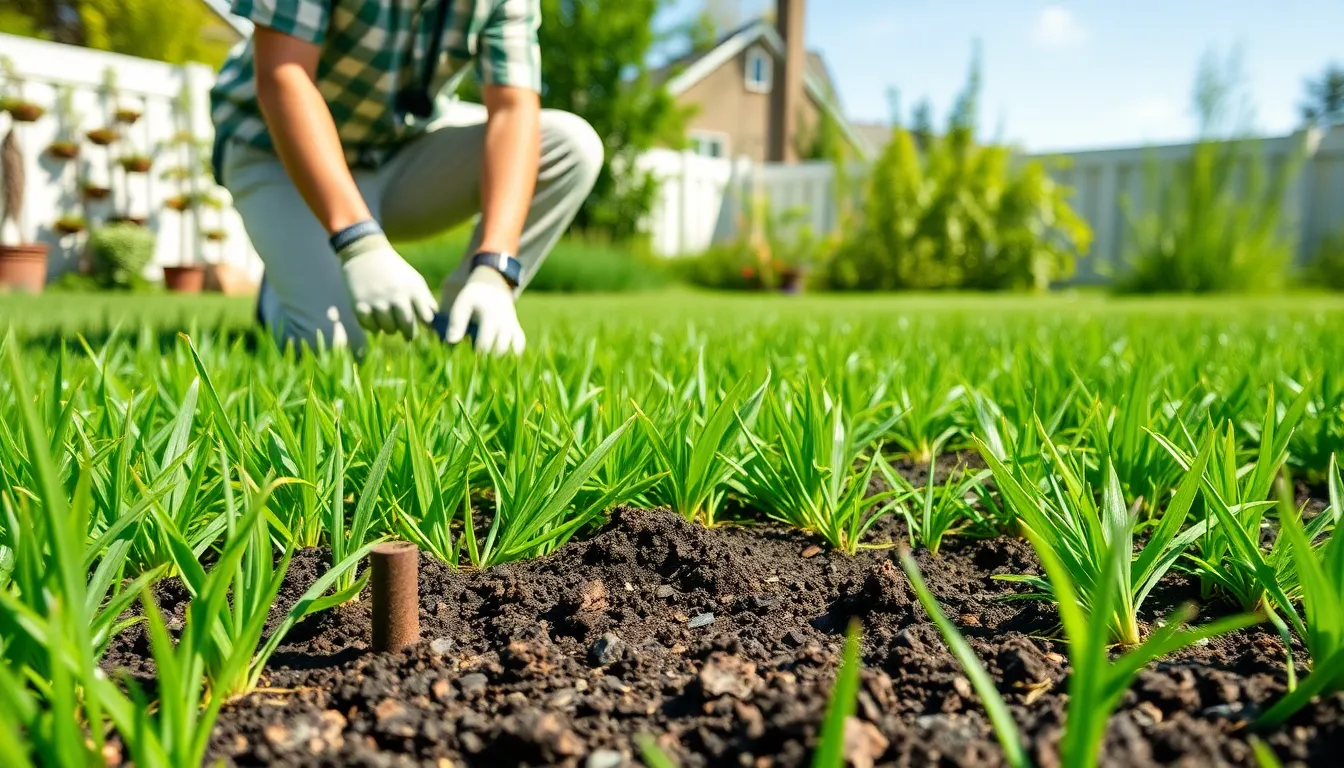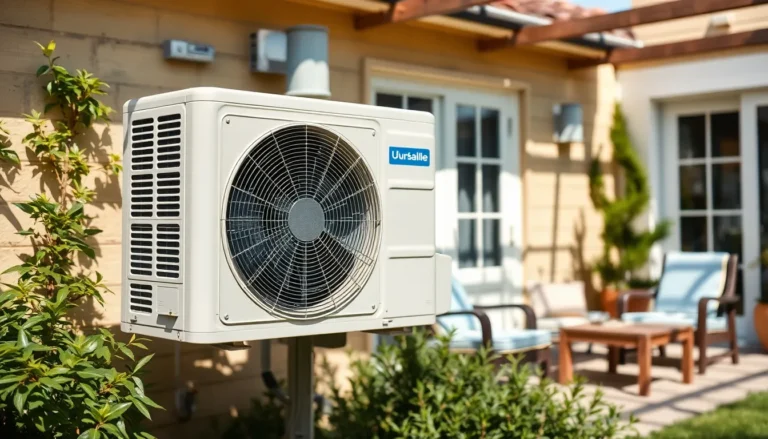A lush green lawn is like the crown jewel of any home, but let’s face it—keeping it that way can be as tricky as herding cats. With the right lawn care techniques, however, anyone can transform their patchy yard into a vibrant oasis that even the neighbors will envy. Who wouldn’t want to sip lemonade on a carpet of emerald grass while their friends marvel at their gardening prowess?
Table of Contents
ToggleImportance Of Lawn Care
Lawn care plays a vital role in creating healthy outdoor spaces. Effective maintenance offers several key advantages, from environmental benefits to aesthetic enhancements.
Environmental Benefits
Healthy lawns contribute significantly to environmental stability. They improve air quality by absorbing carbon dioxide and releasing oxygen. Fertile grass reduces soil erosion, protecting waterways from sedimentation. Lawns also serve as natural air filters, trapping pollutants and dust. Maintaining a lush lawn aids in temperature regulation, promoting lower temperatures in urban areas. Furthermore, proper lawn care practices conserve water by utilizing efficient irrigation techniques. These actions help sustain local ecosystems and enhance biodiversity, further proving that consistent care yields abundant environmental returns.
Aesthetic Appeal
An attractive lawn enhances the overall appearance of a property. A well-maintained yard adds curb appeal, increasing home value by as much as 15%. Neatly trimmed grass and vibrant flower beds create inviting outdoor spaces for relaxation and entertainment. Different landscaping designs can showcase individual style, making outdoor areas more enjoyable. Lush lawns invite gatherings, offering comfortable spaces for families and friends to connect. Satisfying results from effective lawn care lead to personal pride and a sense of community belonging, reinforcing the desire for beautiful outdoor environments.
Key Components Of Lawn Care

Lawn care involves several crucial components that ensure a healthy, vibrant yard. Focusing on these elements helps create an impressive landscape.
Soil Health
Soil health forms the foundation of any thriving lawn. Tests confirm nutrient levels, pH balance, and organic matter content. Amend soil as necessary using compost or other organic materials to improve structure and fertility. Aeration allows air and water to penetrate deeper, promoting root growth. Regularly removing thatch is essential as well since it can suffocate grass roots.
Grass Type Selection
Choosing the right grass type is vital for a successful lawn. Different varieties thrive in specific climates, soil types, and sun exposure. Kentucky bluegrass offers lush green color in cooler climates, while Bermuda grass suits warmer regions due to its drought resistance. Consulting a local extension office provides additional insights on suitable grass types for particular areas.
Fertilization Techniques
Fertilization techniques influence lawn health significantly. Applying slow-release fertilizers ensures a steady nutrient supply, minimizing waste through runoff. Timing applications correctly maximizes absorption; typically, spring and fall serve as ideal periods. Employing nitrogen, phosphorus, and potassium blends supports robust grass growth and resilience against pests and diseases. Following manufacturer instructions prevents over-fertilization, which can harm the lawn ecosystem.
Common Lawn Care Practices
Proper maintenance is essential for achieving a lush, green lawn. Engaging in consistent lawn care practices can make a significant difference in the overall health and appearance of outdoor spaces.
Mowing Strategies
Mowing plays a crucial role in lawn health. Cutting grass at the right height encourages root growth and prevents weeds. Most grass types thrive when maintained at a height between 2 to 4 inches. Regular mowing every 7 to 14 days promotes a thick, healthy lawn while avoiding scalping. Keeping mower blades sharp ensures clean cuts, reducing stress on the grass. Adjusting mowing patterns each time helps prevent soil compaction and promotes even growth.
Watering Guidelines
Watering requirements depend on grass type and weather conditions. Generally, lawns require about 1 to 1.5 inches of water per week. Early morning is the best time to water, minimizing evaporation and fungal growth. Utilizing a soaker hose or drip irrigation can effectively deliver moisture directly to the root zone. At least once a week, deep watering encourages deeper root development. Rain gauges help monitor precipitation, ensuring proper watering schedules.
Weed Control Methods
Weed control is critical for maintaining a healthy lawn. Regularly inspecting for weeds allows for early intervention. Pulling weeds manually or using a hoe can provide immediate, effective results. Applying pre-emergent herbicides in early spring prevents weed seeds from germinating. Maintaining a thick lawn through proper mowing and fertilization discourages weed growth. Mulching around flower beds creates a barrier that protects desired plants from competing with weeds.
Seasonal Lawn Care Tips
Lawn care varies significantly with each season, demanding different strategies for optimal results. Understanding the seasonal needs ensures a vibrant, healthy lawn throughout the year.
Spring Lawn Care
Spring marks the beginning of active growth for lawns. Start by performing soil tests to determine nutrient levels. Aeration helps alleviate soil compaction, promoting better water and nutrient absorption. Fertilization with a slow-release product supports growth at this time. Additionally, overseed bare patches to encourage thick, lush growth as temperatures warm. Regular mowing begins in spring with grass kept at a height of 2 to 4 inches, fostering deeper roots.
Summer Lawn Care
Summer presents unique challenges, like heat and drought. Watering becomes crucial, with lawns needing 1 to 1.5 inches of water weekly. Implementing early morning watering can reduce evaporation. Consider raising mower blades to 3 inches to provide shade for soil, promoting retention. Frequent inspections for pests and diseases should occur, allowing for timely treatment. Employing mulching techniques helps retain moisture and suppress weeds during the hottest months.
Fall Lawn Care
Fall serves as a transition period, perfect for preparing lawns for winter. Start by fertilizing with a high-potassium product that supports root development. Aerate the soil again to enhance absorption of nutrients and moisture. Leaves should be collected promptly to prevent smothering grass. Overseeding at this time rejuvenates the lawn before colder temperatures arrive. Maintaining a mowing height around 2 to 3 inches aids in protecting roots.
Winter Lawn Care
Winter lawn care focuses on protection and maintenance. Snow cover acts as insulation, but any persistent ice should be removed to prevent damage. Avoid walking on dormant grass to reduce stress. Use this season to plan spring improvements, like new grass varieties or landscaping changes. Regularly check for pests that might enter dormancy, taking early action if needed. Limiting heavy equipment use on the lawn during winter helps it recover more effectively when the growing season begins again.
Maintaining a vibrant lawn requires dedication and knowledge but the rewards are undeniable. A well-cared-for yard not only enhances the beauty of a property but also promotes environmental health. By implementing effective lawn care techniques throughout the seasons individuals can experience the satisfaction of a lush landscape that serves as a perfect backdrop for relaxation and social gatherings.
Investing time in soil health proper grass selection and consistent maintenance pays off in the long run. Whether it’s through regular watering or strategic fertilization every effort contributes to a thriving outdoor space. With the right approach anyone can transform their lawn into a stunning oasis that adds value to their home and joy to their life.






